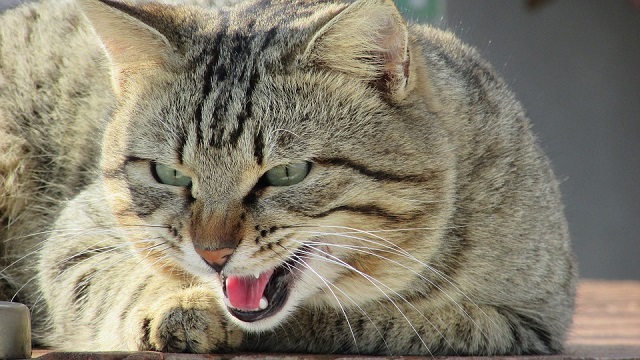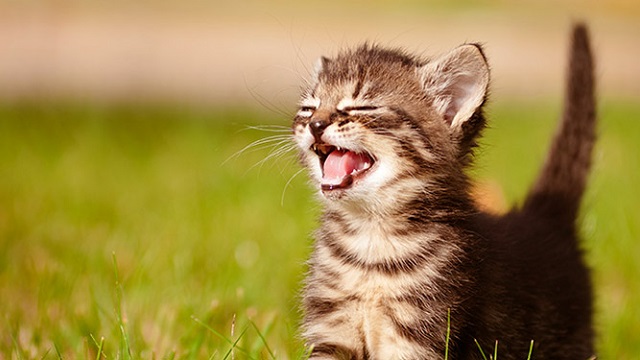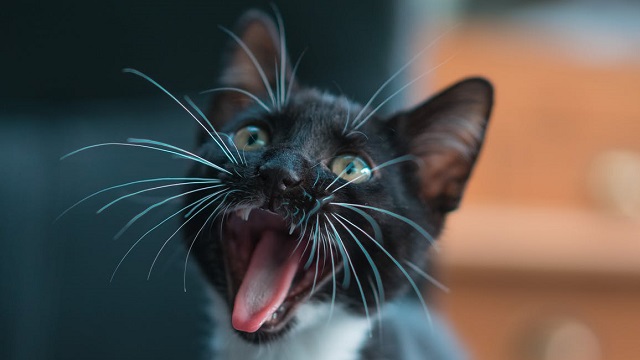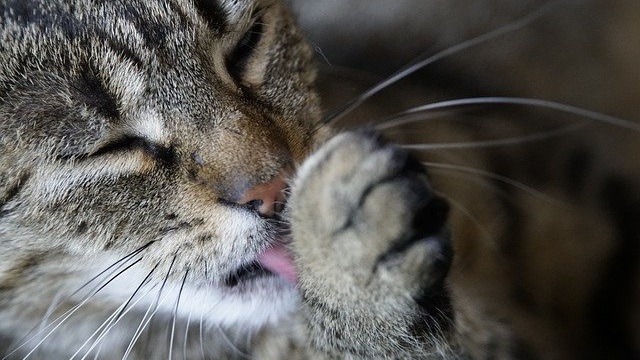Cat language might seem rudimentary with its short vocabulary, but don’t be fooled. It’s much more complex than it looks, with intonation, repetition and sound volume playing important roles in giving those meows different meanings. Unfortunately (and astonishingly, to every cat lover!) there is still no translation device that can help us have a thoughtful and deep conversation with our little balls of fur. ? So, we’re stuck with the basics. But basic as they are, they’re still quite insightful! Ready to dwell into the mysterious paths of cat language?
Purring

As far as cat language goes, this may be one of the most recognizable sounds of all.
Purring usually means they are content and happy. Cats can purr while eating (when food tastes great) or when you are petting them just right, as if to say “please, more, more!”. ?
However, felines can also purr when feeling sick or afraid. The soft vibrations through their body help them relax, and they’re believed to have healing powers.
Chirps
Now, this is a hard one. Cat language includes chirps and chitters which sound very similar to the untrained ear, but have completely different meanings. The easiest way to distinguish both is through body language and context.
Mothers chirp to tell their kittens to call them and tell them to follow. Adult cats don’t chirp at each other, but they will likely chirp at you for the same reason as their moms did. Which leads us to an interesting fact: since cats don’t usually meow at each other, scientists believe they talk to us because they assume we are either their kittens or their moms! ?
Chattering and chittering
These sound very similar to the aforementioned chirps, but there is nothing sweet about them.
You might find your cat making these noises while sitting at a window attentively checking squirrels and birds. Unfortunately, we still don’t know exactly what they mean, but since it’s usually targeted at preys, scientists believe it’s a threat and a warning. It is almost as if our felines are reproducing the sound of their teeth breaking the little necks of those animals… ?
Growling and hissing

These ones don’t need any explanation, right? Move along and leave the cat alone. They’re not in a good mood and you shouldn’t push your luck!
The cat is likely very angry or very scared and they’re issuing a warning: an attack is imminent. ?
Yowling and howling
Yes, cat language also includes yowling and howling. We’re talking about those long, loud and drawn-out meows cats do when they’re distressed or in pain. You may recognize them from when your friend gets stuck or is locked somewhere.
Unneutered and unspayed cats also yowl as part of their mating behavior, annoyingly shouting all day.
The meows

A meow is a meow, simple as that, but the way cats say it can also convey different meanings.
A single, soft meow is usually a simple greeting, like a “hello”. Multiple meows indicate a more complex conversation, but we can’t be sure of what they are saying. Maybe they’re just asking what have you been doing, maybe they’re telling you about their day, maybe it’s something completely different. Who knows? ?
Low pitched meows that turn into soft growls are small protests, like an old man rambling against something. However, when they are high pitched, that’s a straight shouted complaint. If you ever accidently step on a cat’s tail, you know what we are talking about.
Finally, drawn-out meows are the equivalent of a human’s pleading. Just like a kid asking for a new toy or a candy. A sort of “Please, please, pleeeeeeaaase”.
Can cats understand us?

Up to a certain point, but it’s not clear which point that is.
Several studies were already conducted to try to understand if cats can comprehend human language, but they all faced a similar problem: cats simply don’t care. It’s hard to measure if they understand our words when they keep their poker-faces up all the time.
There are some indications that felines can recognize certain words (like their names) due to constant repetition. Nevertheless, scientists stress that more than words, they can interpret our voice tones. This explains why they are more likely to come if you happily sing their name, rather than when you use a sterner tone.
On a positive note, though, a study led by Tokyo University in 2015 concluded that felines can at least recognize their owner’s voice. They would turn their ears and sometimes their heads towards the familiar voice and their pupils would dilate indicating excitement, but that was about it. The cats didn’t try to follow the voice like dogs do, and even though they could clearly grasp that something was happening, they just stayed cool. ?
You may get a full Ph.D. in cat language, and you still won’t be close to mastering it. Their mysterious sounds paired with their unfathomed personalities are hard to interpret. Luckily, we have spent enough time with them to be able to at least recognize something.
Just don’t jump to conclusions and pay close attention to their non-verbal communication for clues. Understanding your cat’s tail can also give you a good insight of what’s going on in their heads, as well as the way they move their ears and their pupils’ reactions. In the meanwhile, just have fun with your little buddy and cross your fingers for some tech genius to come up with a good translation device! ?






